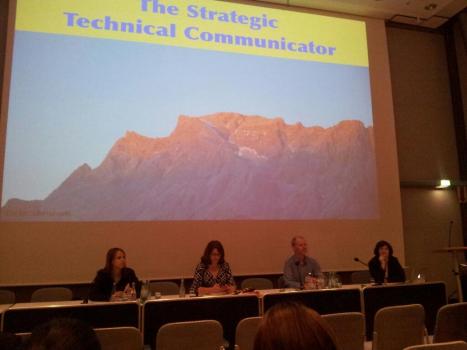On its first day of sessions, TCUK13 offered very diverse sessions. My selection of presentations – and hallway conversations – focused on cognitive science, the future of tech comm, the business side of our industry as well as managing tech comm, this year’s specialist stream.
Sarah O’Keefe on “Fame, glory and… tech comm”
Sarah’s opening keynote urged us to unleash our inner pirate and “go for the booty” of corporate resources and attention – in other words: to follow the money. We tech comm’ers need to understand the objectives and KPIs of C-level executives, develop a content strategy that supports these objectives and then profit (before marketing or other departments do, as Ellis Pratt later pointed out in his rant).
This way we can create effective tech comm which meets both business needs and user needs – as opposed to artisanal tech comm which fails business goals or cheap and merely adequate tech comm which fails users.
My session on semiotics and mental models
My own presentation Addicted to meaning: Mental models for technical communicators was attended by approximately 50 people and quite well received, I thought.
It’s essentially a brisk walk through a couple of cognitive concepts that underlie much of tech comm. After considering what meaning actually is and why we technical communicators should even care, I looked to semiotics to explain how meaning works in communication – and why it still sometimes fails in tech comm. The second concept is mental models which can explain how and why we create meaning – and how we can create meaningful documentation.
Adrian Morse on “The challenges of remote management”
Adrian drew on his experience of both working at home and managing technical communicators who work at home to explain many of the challenges of managing writers remotely. His tips applied to most teleworking scenarios, from occasional home office days to full-time teleworking by some or all of the team members.
Remote working and managing requires thought-through policies and a good reliable setup that starts with the appropriate hardware and network services and extends all the way to regulating PC administration, backup policies, etc. and complying with corresponding laws and EU regulations.
Adrian emphasized how important communication is as long as someone, anyone teleworks: You need to agree on mutual expectations in terms of hard objectives and performance, but also in terms of softer factors of answer times and availability for mail and phone contact. Just as working face-to-face, teleworking requires regular meetings, both 1-on-1 and of the team as a whole. Also make sure you have good ideas and policies for when and how you allow people to enter teleworking scenarios and when and how they will end them again!
Ray Gallon on “The Quantum Funnel”
Ray’s talk dovetailed with my own: His reference to creating scripts which explain how we behave in a restaurant was very close to my own example of how mental models determine our approaches to and perceived options in restaurants.
His premise is that today’s practice of learning is much more scattered and autonomous than it has previously been when learning was more controlled and directed. Such learning leaves more and more crucial gaps than before. To make sure that people (and users of tech comm specifically) can successfully fill their knowledge gaps, learning becomes more important than knowing.
One such approach is “connectivism” which understands learning as the process to search and connect concepts, ideas and fields. In this context, learning must not only answer the questions “what?”, “how?”, “where?” and “when?”, but also “how to be?” and “how to be with others?”. People in general and tech comm audiences in particular, increasingly learn in self-directed and creative ways by social collaboration, together with others. The role of teachers shifts to facilitator, that of technical communicator to curator.
This will emphasize both social and cognitive skills in the future, when we learn by moving through these stages:
- Exploring and understanding
- Representing
- Planning and executing
- Monitoring and reflecting
Applied to tech comm, this means our model shifts from a gatekeeper of knowledge to that of a curator and storyteller, as we avail ourselves of different types of contextual information, some of which our outside of our control:
- Internal documentation, such as progressive disclosure.
- External information, such as it is in Wikipedia.
- Interactive information, such as MOOCs and commenting functions support them.
– Feel free to leave comments about any of the sessions, whether you have attended them or not. I will try to answer them as well as I can.
Filed under: cognition, conferences, content strategy, managing | Tagged: Adrian Morse, Ray Gallon, sarah o'keefe, TCUK13 | Leave a comment »







